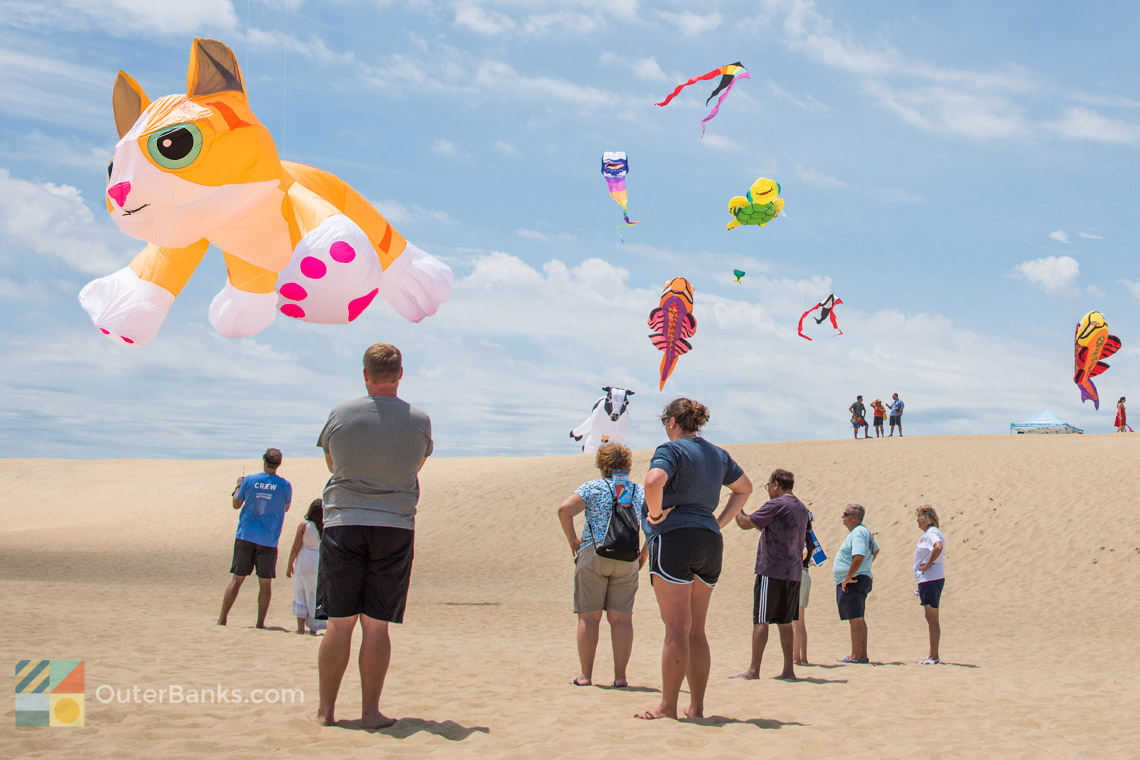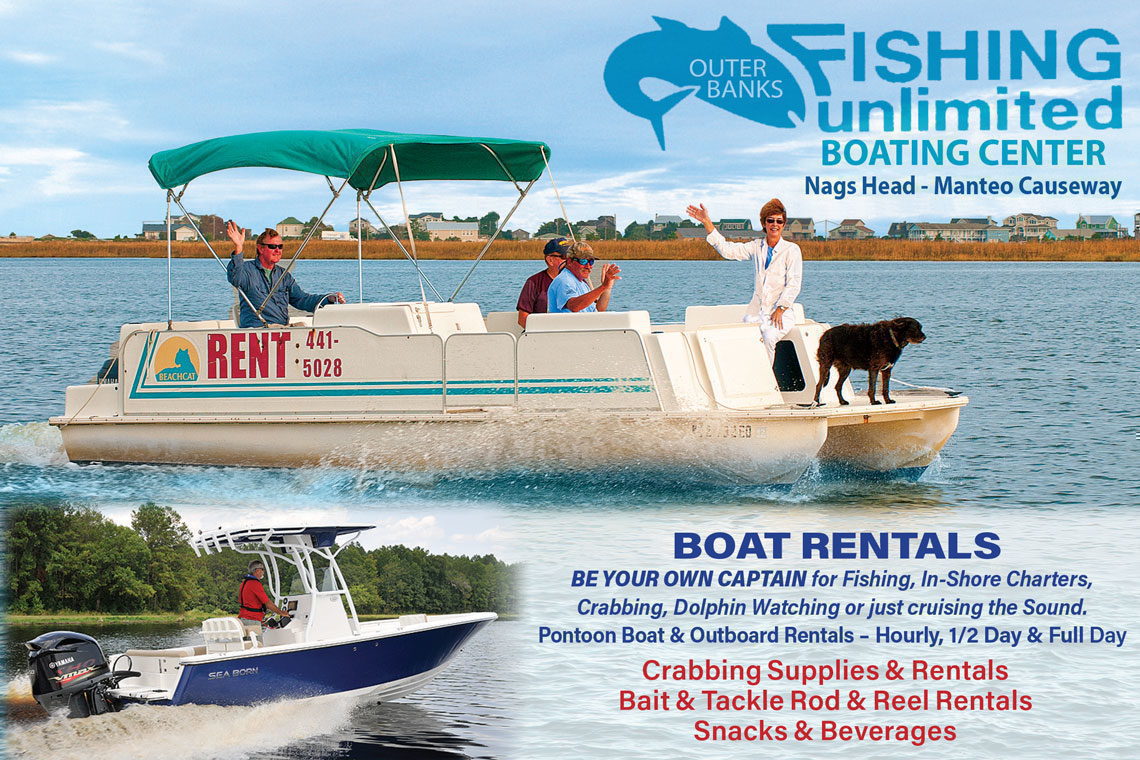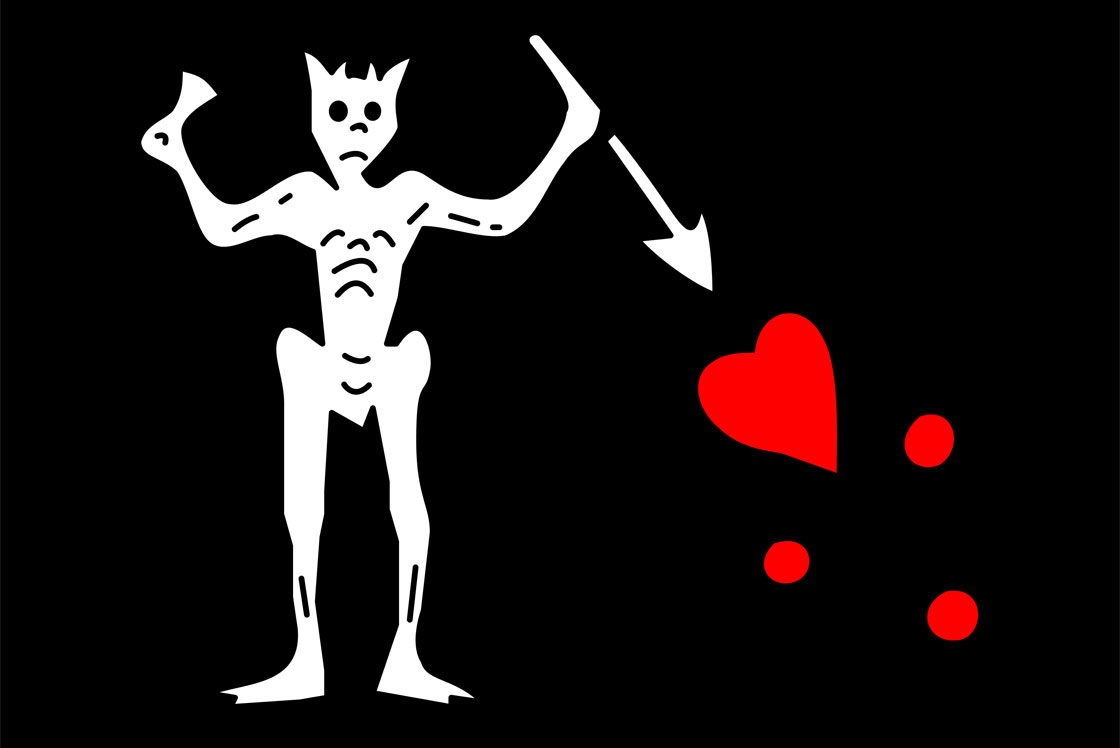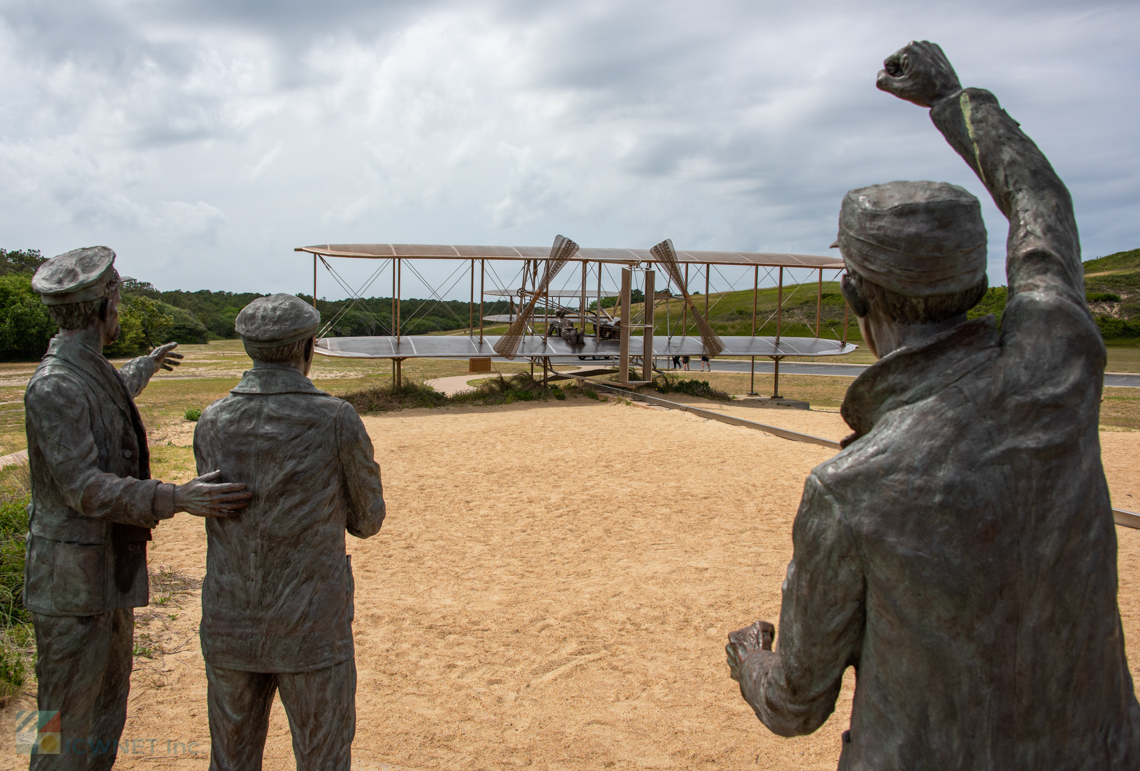The Outer Banks is clearly known for its exceptional fishing, but for sporty vacationers who want to try something new, or take on an outdoors activity the entire family can enjoy, crabbing is a fun way to get your toes wet in the local Outer Banks fishing scene.
The Outer Banks is known for its large supply of Blue Crabs, and these crabs wind up on the daily menus of Outer Banks restaurants all along the coast. But many first-time visitors are surprised to learn that crabbing, though a little tricky, can be easily conducted off the soundfront backyards or waterfront docks of a vacation rental home, anytime of day, and nearly any time of year.
For a home caught dinner that's fresh off the docks, or a new way to enjoy the abundance of Outer Banks fishing and seafood, try a little crabbing on your next beach vacation.
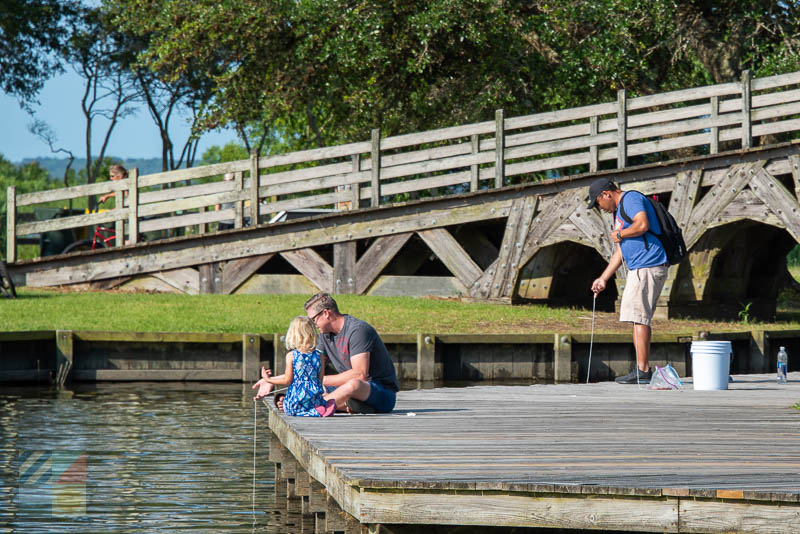
Crabbing Permits
Before you start, you'll need to check whether you'll need a North Carolina Fishing License, which is distributed by the North Carolina Wildlife Resources Commission and can be purchased online before your vacation, or at the majority of local Outer Banks tackle shops.
Individuals do not need a license to set one pot per person from a private pier or shoreline, so long as he has permission of the property owner. A private pier or shoreline means there is no public access and does not apply to fishing piers where the public pays for fishing privileges. Recreational harvest limits apply. Sale of catch is prohibited. No buoy or identification required.
Individuals do not need a license for chicken necking or legging. Recreational harvest limits apply. Sale of catch is prohibited.
Individuals do not need a license to use collapsible crab traps so long as the largest open dimension is no larger than 18 inches and the traps are designed to collapse at all times when in the water, except when they are being retrieved from or lowered to the bottom. Recreational harvest limits apply. Sale of catch is prohibited.
Otherwise, a Recreational Commercial Gear License (RCGL) is required.
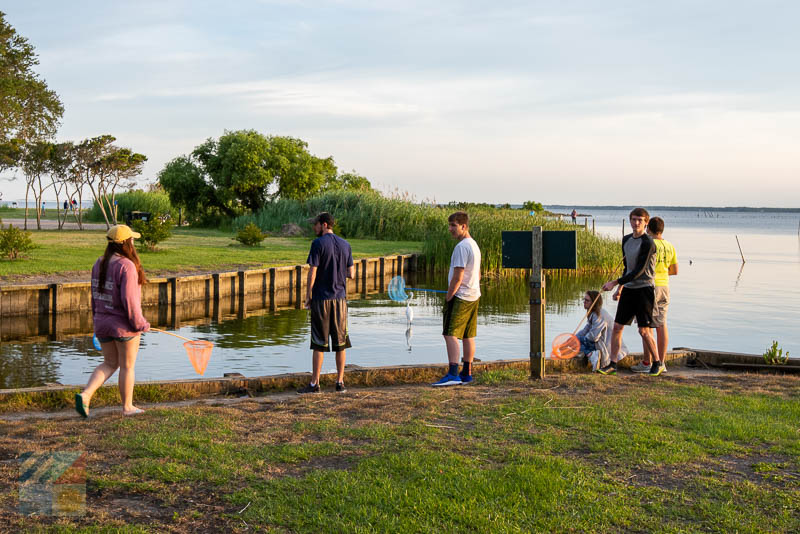
A Crabbing "How to"
When it comes to non-commercial crabbing, there are quite a few methods on the Outer Banks. Two of the most popular methods are with crab pots and by "Handlining."
Crab pots aren't actually pots - they are wire boxes that resemble chicken coop cages. Visitors often spot collections of these square wire cages by harbors or marinas, or in front of local homes serving as yard decor.
Crab pots have two holes entering into the cage that are conical and become smaller as the holes lead into the center. This makes it easy for a crab to enter the cage, but nearly impossible to exit. Crab pots can usually be purchased at a number of larger marinas on the Outer Banks, or larger fishing supply and tackle stores, although it is not unusual for DIY types to pick up some chicken wire and binding material to try and construct their own.
To go crabbing with a crab pot, the fisherman places chunks of raw chicken or other meat into the bottom of the pot and lowers it gently into the water. After that, it is merely a waiting game. After an hour to a few hours, the fishermen returns to lift the crab pot up out of the water and see if any crabs have literally taken the bait.
Crabbing with crab pots is relatively an easy, hands-off approach to crabbing. For aspiring crabbers who want a little more adventure, the handline method can be very satisfying.
Next, you'll want to find a secluded sound or canalfront location to drop your line. This can be done from the back of small skiff in the Roanoke, Albemarle or Pamlico Sound, or from a sandy soundfront beach, or simplyfrom a saltwater-bordering dock in your backyard. Look for areas with slightly deep water, about 2ft - 5ft deep at the most, for the best chances of pulling in a crab or two. Note that crabbing is most always done in sound waters, not in the ocean where the steady pummeling waves can easily get in the way.
Once you have your license and location squared away, you'll need a long cord of fishing line, about 15ft - 20ft, a little bait, and a small fishing net. For bait, most crabbers use chicken or turkey legs, although seasoned fishermen can try to use small bait fish, like mullets or minnows, to improve their chances of catching a fish as well as a crab.
Tie your bait to one end of the fishing line and toss it into the water. You can hold onto the other end, or tie it to a dock post or fishing pole holder. Make sure there is some slack on the line so it's easy to detect movement. Then simply wait, and as soon as the line starts to tighten, it's a sure sign that there is a crab at the other end, enjoying the bait.
The key to handline crabbing is to be patient, and to slowly reel in the line without disturbing the crab on the other end, happily munching away at the bait. If a crabber can reel the line in slowly and gently enough, the crab will hang on, allowing the crabber to bring the crab close to the surface and then dip the small fishing net into the water under the crab, scooping him out of the water.
For crabbing with either method, keep in mind the state crab regulations. The maximum number of crabs an individual can catch in one day is 50, and crabs must be between 5" - 6.75." You'll also want to be sure you have an empty cooler on hand to keep the crabs fresh, and watch out for the claws. Crabs can very easily be attached to the crab pot or the fishing net, and a little patience is required to slowly maneuver them out. Try to grab the crab from the backside, to protect your hands, or wear thick rubber gloves when extracting.
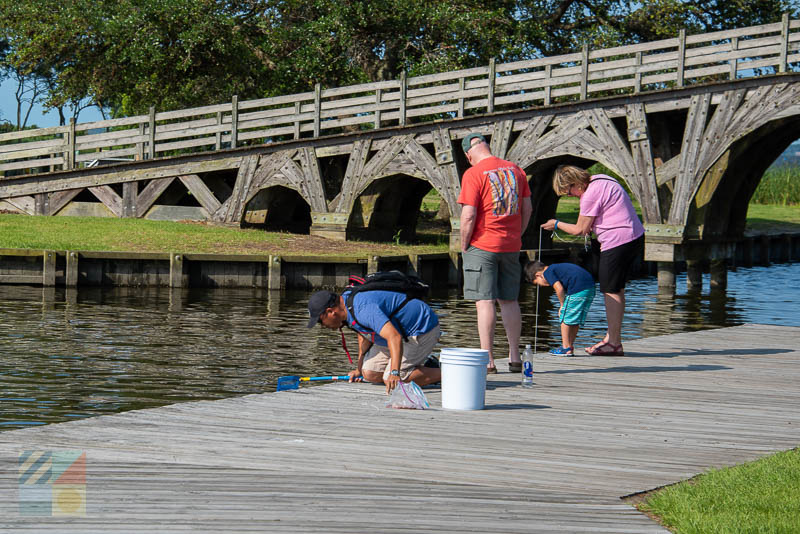
Where to go Crabbing on the Outer Banks
The best part of Outer Banks crabbing is that there is literally an endless variety of places to go. From wide sandy beaches to quiet sandy canals, crabbing on the Outer banks can occur virtually anywhere there is sandy sound water.
If crabbing is an integral part of your vacation plans, you may want to ask your property management company about canalfront vacation rental homes and condos. The term "canalfront" generally refers to homes or properties that border a saltwater canal, a veritable branch of the Currituck, Albemarle, Roanoke, or Pamlico Sound, and an ideal location for Outer Banks crabbing.
Also, be on the lookout for waterfront vacation homes with docks or bulk headed locations. Properties that have their own dock or bulk headed site overlooking a sound or canal offer backyard access to crabbing, any time of day or night, with all the comforts of your vacation rental home just steps away. This is especially ideal for crabbing kids, as they can stay close to home while enjoying a bit of the Outer Banks crabbing scene.
For vacationers who aren't staying waterfront, there are a variety of public locations to explore that offers optimal Outer Banks crabbing.
In Corolla, crabbers can head to the Historic Corolla Park, which offers both a selection of small saltwater ponds and a wide soundfront beach and wooden boardwalk which overlooks the Currituck Sound. This location in particular, and any soundfront boardwalks for that matter, is exceptional for crabbing, as the crabber can stay high and dry while dipping their line in a few feet of water.
One of the most popular spots in the Central Outer Banks is well off the main drag, in the Colington area of Kill Devil Hills. Located west of the main US 158bypass, this Outer Banks area is a collection of residential and vacation rental homes that border an intricate system of saltwater canals. In fact, the majority of homes in this area are canalfront, and there are a small number of public parking areas and parks that include dockage and access to these crab hotspots. Be prepared to be surprised - with the exception of fantastic sound access and gorgeous waterfront sunsets, Colington looks nothing like its Outer Banks neighbors, and features a maze of hilly residential areas and wooded neighborhoods.
Further south, in between Nags Head and Manteo, crabbers congregate at the locally known "Little Bridge," a waterfront platform that lies alongside the Nags Head-Manteo causeway over the water. Public parking is available, as well as restroom facilities, and a number of crabbers come here for an afternoon of mingling and handlining.
Downtown Manteo is also an exceptional place to go crabbing, particularly the outskirts that are well away from the marinas, but still have bulk headed areas to dip a line. Small soundfront gazebos offer refuge from the sun, and a number of picnic and sitting areas are scattered throughout the area.
Hatteras Island also has a number of fantastic crabbing spots. The town of Frisco on Hatteras Island also offers an abundance of waterfront neighborhoods with plenty of crabs just lurking beneath the surface. Brigands Bay and Sunset Harbor are two communities that offer plenty of spots to drop a line or a crab pot.
In neighboring Hatteras Village, crabbers can explore the small boardwalks of the Eagle Pass Nature Trail, or head to the soundside of Hatteras Inlet, to park and crab the day away. Be advised that a beach driving permit is required to explore the 4WD accessible sandy trails that wind past Hatteras Village all the way to the inlet. This area, however, offers plenty of secretive soundside beaches where crabbers can drop a line out from the beach, or wade a few feet into the sound and try their luck in deeper waters.
Ocracoke has a similar crabbing atmosphere, with a handful of soundside access points along both Hatteras and Ocracoke Inlets, as well as various parking areas along NC Highway 12.
The unique thing about Ocracoke, however, is that beach visitors have a chance at catching crabs in the oceanas well in the sound, and a number of blue crabs can be spotted during the warm summer months scooting across tidal pools and sandbars in the Atlantic. Bring a net along on your next Ocracoke beach trip, and wade out into the ocean for a chance to catch these suckers as they scurry by. Non-crabbers in the water should be mindful of their toes, and should venture out into the ocean with an "Ocracoke Shuffle," a slight shuffling of the feet that notifies other crabby ocean goers of their presence.
Ocracoke Harbor in the heart of the village can also be a good spot to go crabbing, provided that crabbers stay far away from the congested small marinas. A handful of crabs can generally be found by busy ports, but not many, and quieter waterfront locations are the best for crabbing.
For Outer Banks Crabs without the Fuss
Of course, if your crab pots come up empty, or you want to enjoy the taste of a crab or twelve without the effort, there are a number of seafood shops and markets all along the Outer Banks to curb your crab appetite.Seafood market patrons can order steamed and seasoned crabs that are ready to eat, or live crabs by the bushel to take home and cook for a crab feast.
Many locals attest that the best way to enjoy crabs are steamed, (in a large steamer pot if one is available), with a healthy dose of Old Bay seasoning. After that, it's just a matter of taking off the upper shell, breaking the crab in half with a knife, (or with strong hands for the more adventurous in your group), and then breaking each half in half a second time, making it easy to get to the sweet meat in the four sections. A little melted butter for dipping goes a long way, and a nutcracker can also come in handy for extracting meat out of the bigger claws.
Of course, a number of local restaurants also offer crabs legs as a regular feature on their menus, and there are a handful that also offer all-you-can-eat style feasts that attract hungry vacationers on a nightly basis. You may want to check ahead and see what types of crabs are featured. While Alaskan King Crabs may be flash-frozen, and therefore as fresh as possible so far from the West Coast, Blue Crabs are a key staple in local eating.
For an indulgence in crab cuisine without all the work of fishing out the meat, try the she-crab soup at your favorite Outer Banks restaurant. A local specialty, this cream based chowder is made with crab eggs, cream, and spices, and is completely delicious.
The Outer Banks is serious about its crabs, and vacationers can readily enjoy these Outer Banks natives, whether they are plucking them from a soundfront or canalfront dock, or heading to their favorite local dive for a crab-leg feast. Crabbing on the Outer Banks is popular because it is so easy to do, and produces such a tasty result. All a fishermen needs is a crab pot or a line, and a little raw chicken, and a crab dinner can be held within just a few hours.
On your next Outer Banks vacation, take to the water and try your hand at crabbing. A pastime that fishermen of any age can enjoy, crabbing on the Outer Banks is a nunique adventure to try out on your next beach vacation.
-
Tipsy Turkey Beer Mile
November 26th, 2025 10:00 AM -
Surfin' Turkey 5k and Puppy Drum Run
November 27th, 2025 -
Outer Banks Running Club OBX Gobbler 5K & Fun Run
November 27th, 2025 8:00 AM
Owned by Garry Oliver, the proprietor of the Outer Banks Fishing Pier, this small wooden aqua blue-colored store on the Nags Head-Manteo causeway has been serving the needs of fishermen for decades. A full line of tackle is available for all types...
The Southern Outer Banks, particularly Ocracoke Island, is notorious as the stomping grounds for some of history's most infamous pirates. Notable swashbucklers from Calico Jack to Anne Bonney and Mary Reed, arguably the most famous women pirates...
Founded in 1984 on the coast of the Outer Banks, NC, Farmer’s Daughter still remains a destination for people wanting great quality, outstanding selection of unique clothing, accessories, and gifts at affordable prices. Committed to offering...
The Wright Brothers National Memorial is a "Must See" attraction for any Outer Banks aviation enthusiast, history lover, and virtually any Kill Devil Hills vacationer who wants an up-close look at the towering granite structure that towers over the...
You haven’t experienced North Carolina until you’ve experienced North Carolina BBQ, and Pigman’s Bar-B-Que offers excellent North Carolina BBQ meals served with southern hospitality. Pigman’s offers traditional eastern...

